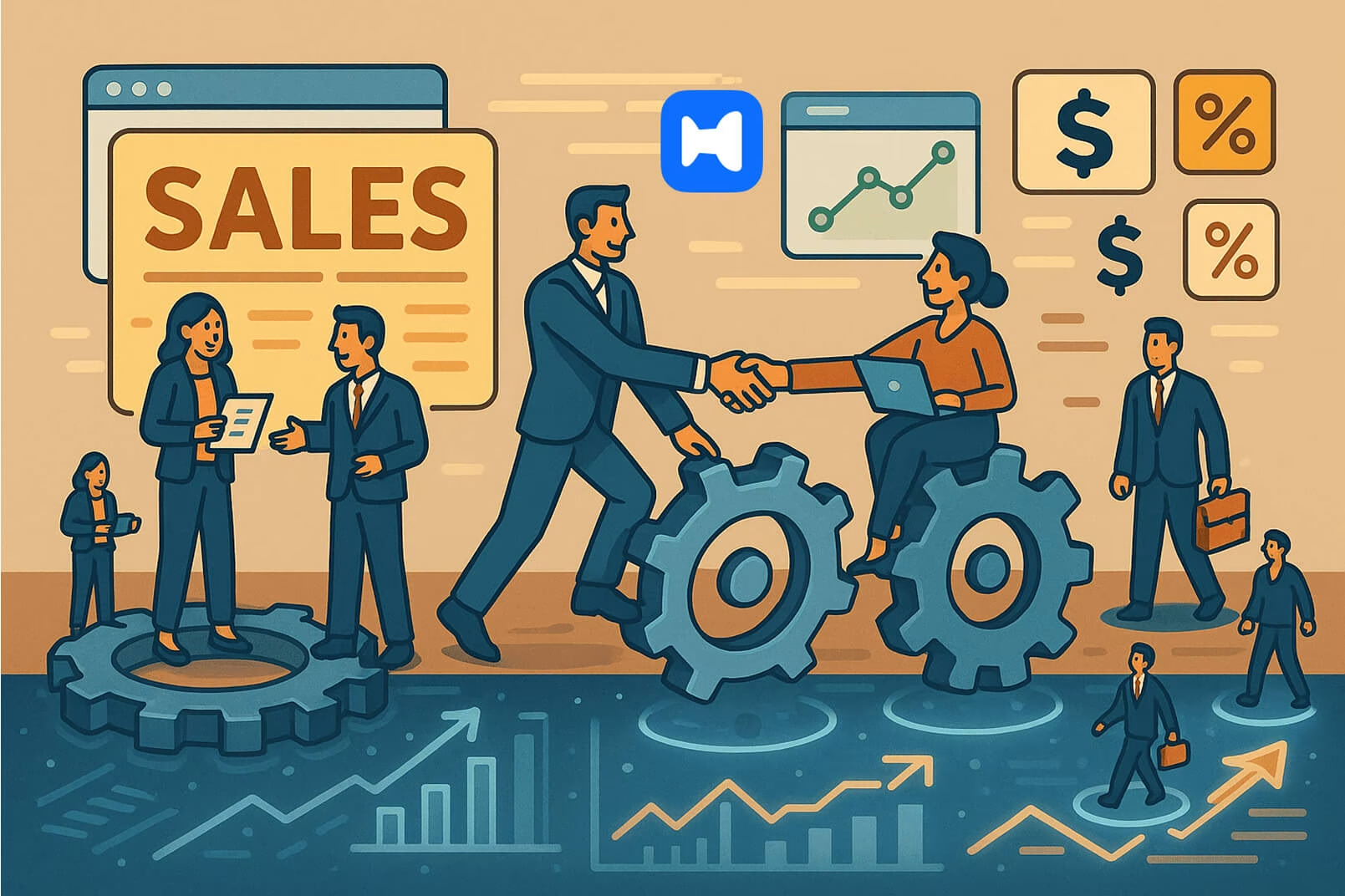What Sales Enablement Really Means
Sales enablement isn’t just another tech buzzword—it’s the line between reps who chase deals and those who close them. If you’re still relying on outdated salesman tools or spreadsheets that haven’t been updated since Q2, you’re not just behind—you’re bleeding revenue. This isn’t about “doing more with less.” It’s about giving your sales team an unfair advantage using the right sales enablement tools to streamline the sales process, shorten the sales cycle, and improve overall sales performance.
Why Sales Enablement Matters More Than Ever in 2025
Your sales reps aren’t lazy—they’re buried. Updating customer relationship management systems, hunting for decks, scheduling meetings, chasing marketing teams for one-pagers—it’s death by a thousand tabs. Sales enablement tools aren’t optional—they’re the only way your sales operations stay competitive in today’s hyper-paced landscape.
.avif)
A strong sales enablement strategy, driven by smart platforms, allows your sales professionals to boost sales productivity by reclaiming hours lost to context switching, scattered tools, and manual admin. It means sales reps spend more time on demos, calls, and strategic follow-ups instead of chasing one-pagers or booking meetings.
Automation handles repetitive tasks—think: call summaries, follow-up emails, or pre-meeting prep—while content surfacing tools ensure the right deck lands in the right hands, without Slack ping chaos.
For sales leaders, this translates into cleaner sales metrics, better forecasting accuracy, and team performance that actually scales.
Key Roles in Enablement: Who’s Driving This Machine?
Sales reps use sales enablement software to prep for sales calls, run demos, and follow up. Sales managers use it to measure sales productivity, manage team performance, and enforce sales strategies. Sales enablement managers—those who truly own sales enablement—build repeatable systems that connect the sales team with the marketing team and customer success teams.
Sales enablement professionals are often the bridge between sales and marketing. Without them, even the best sales enablement platform ends up as shelfware. They ensure that sales enablement resources and sales playbook software are actually used.
Salesman Tools: Still Relevant or Time to Upgrade?
Sticky notes and gut instinct built the old-school pipeline—but that era is over. The modern sales process demands more from sales professionals. The right sales tools can help streamline sales processes, improve the customer experience, and give your sales and marketing teams shared visibility.
Sales enablement platforms today integrate CRM systems, content management, and AI powered analytics to help sales reps focus on high-value activities. These tools increase sales productivity by automating administrative tasks and allowing sales representatives to focus on what they do best: closing deals.
Trends That Actually Do Something
There’s plenty of noise out there. But certain trends in sales enablement software actually help boost sales productivity:
An enablement tool like Wellpin helps sales enablement professionals and sales enablement teams clean up time zone chaos and back-to-back meetings. Sales reps spend less time on admin and more time advancing sales qualified leads. Integrated with CRM, Wellpin automates reminders, reduces administrative tasks, and fits right into your broader sales enablement efforts.
How Top Sellers Actually Win Now
Want to know what really separates top sellers from the rest? It’s not louder pitches or fancier decks — it’s operational clarity. Below the surface, high-performing sales teams are running smarter systems that quietly erase the friction everyone else still fights.
❌ Sales reps spend most of their time on admin
✅ Automate repetitive tasks and get reps selling
❌ Sales professionals stuck onboarding for 2 months
✅ Sales playbook software gets them ramped faster
❌ Marketing content sits unused
✅ Content management system delivers what’s needed
❌ Sales efforts lack direction
✅ Sales enablement manager ensures alignment
You can’t measure sales productivity or improve sales efficiency without real ownership. The best sales enablement tools ensure every rep—from new sales reps to seasoned closers—stays aligned and effective.
What Tools Actually Work for Sales Teams
There are thousands of sales tools out there—but only a handful actually move the needle. These are the ones real sales teams use to close deals faster, reduce friction, and stay on top of the pipeline.
Wellpin often connects the dots for sales enablement teams—especially when juggling multiple tools, reps, and sales qualified leads. When your sales and marketing teams run on sync, customer satisfaction and team performance follow.
Why Marketing Teams Needs a Seat at the Enablement Table
Still treating marketing like the content department? That’s a miss. Your sales enablement strategy works only when sales and marketing teams operate on the same pipeline logic. With aligned sales content, coordinated sales activities, and shared data, your reps don’t waste time chasing PDFs—they enter every sales call armed and on message.
Smart sales enablement leaders know this. They treat marketing automation and customer data as part of the same playbook—not someone else's dashboard.

How Enablement Changes the Math Behind Your Pipeline
When enablement is fully owned—not half-implemented—your sales pipeline moves faster, cleaner, and with way less waste. Don’t take our word for it—look at the deltas.
Sales enablement tools aren’t fluff—they drive real business results. When sales reps have the right platforms, training, and workflows, they close more deals, faster. And when the sales enablement strategy is owned, implemented, and integrated with tools like Wellpin, the results compound. Whether you're trying to increase sales productivity, reduce sales cycle length, or boost overall sales performance, enablement is your multiplier.
How One Sales Team Cut Ramp Time in Half
Not every team needs more tools—most need better alignment. This short case shows what happens when a scattered sales process gets structured around enablement. The difference isn’t subtle—it’s operational.
They empowered sales reps, aligned sales enablement efforts, and finally had the data to measure sales productivity properly.
Final Word: 7 Things Every Sales Team Should Take From This
- Sales enablement is not a department — it’s a system.
If no one owns it, your tools turn into shelfware and your sales reps waste hours every week. - Automation ≠ overkill.
The right sales tools (like Wellpin) eliminate low-value work: follow-ups, scheduling, CRM updates — giving your sales team time to actually sell. - Good onboarding cuts ramp time in half.
With structured sales playbooks and smart content delivery, new sales reps can start closing weeks faster. - Your CRM isn’t enough.
Without sales enablement software, it’s just a data dump. Enablement adds logic, coaching, and real-time support to the sales process. - Content only works if it’s surfaced at the right time.
A solid sales enablement strategy connects marketing teams and sales professionals — and makes sure the right asset shows up before the pitch, not after it. - If you can’t measure it, you can’t scale it.
Enablement gives you the clarity to track sales productivity, evaluate sales performance, and run smarter coaching. - Reps don’t need more tools. They need fewer tools that do more.
That’s why platforms like Wellpin—which automate the boring stuff and tie into your existing stack—actually get used.
Sales enablement isn’t optional anymore—it’s how high-performing teams operate. The faster you commit to it, the sooner your reps stop surviving and start scaling.



